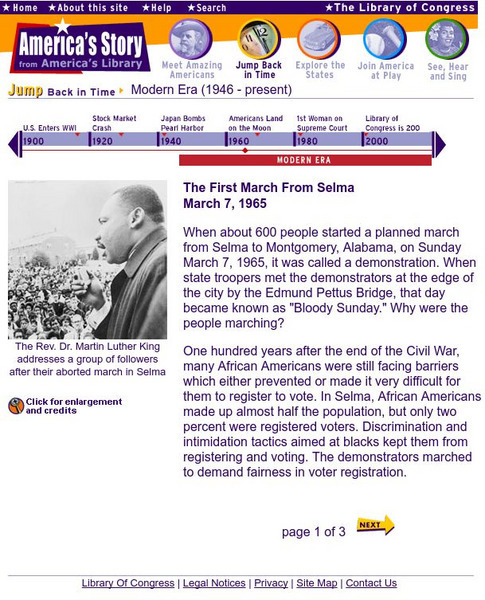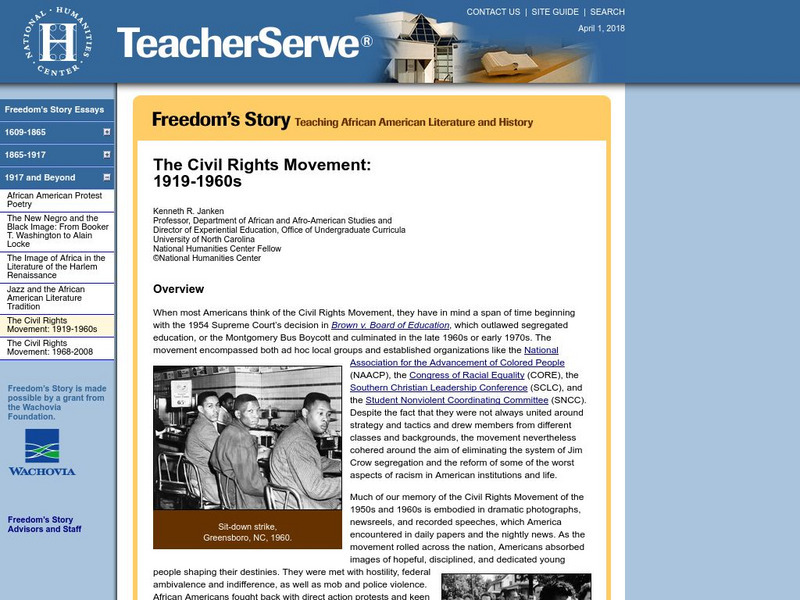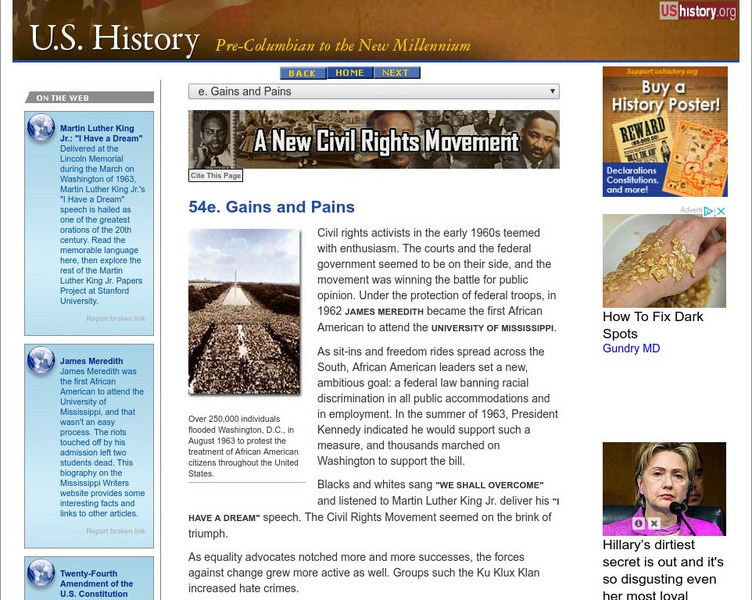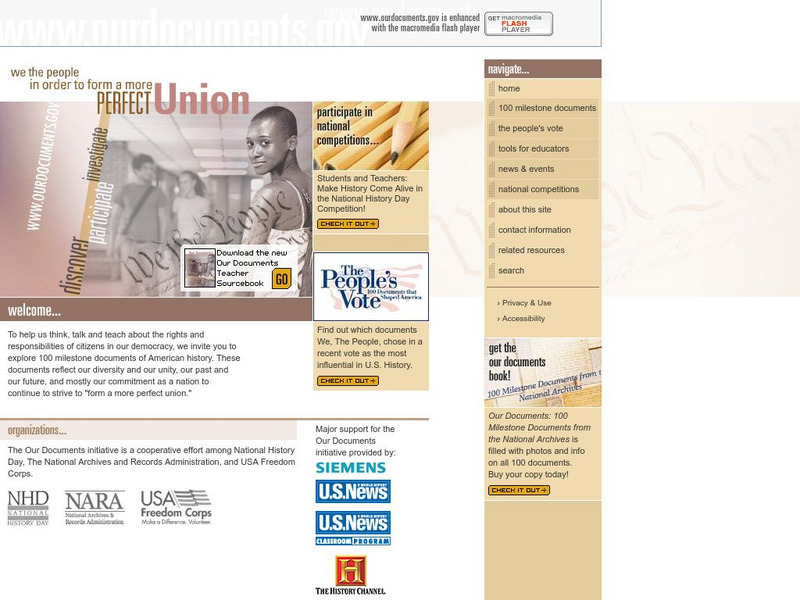US National Archives
Docsteach: To What Extent Was Reconstruction a Revolution? (Part 2)
This activity is a continuation of the instructional activity for Part 1. In it, students will examine the Voting Rights Act of 1965 and determine whether their analysis of this document changes their responses to the guiding question in...
Digital History
Digital History: Affirmative Action and the Case of Allan Bakke [Pdf]
The history of affirmative action was interwoven with the Civil Rights Act of 1964 and the Voting Rights Act of 1965. Read about how the federal government under both President Kennedy and President Nixon attempted to open up jobs to...
Gilder Lehrman Institute of American History
Gilder Lehrman Institute: History Now: Securing the Right to Vote: Selma to Montgomery Story
[Free Registration/Login Required] Lesson plan asking this essential question: "What conditions created a need for a protest march from Selma to Montgomery in 1965 and what did that march achieve?"
Library of Congress
Loc: America's Story: The First March From Selma
This article details a key event in the civil rights struggle--the demonstration organized by the Rev. Martin Luther King in Selma, Alabama on March 7, 1965, when 525 people met a police blockade on the Edmund Pettus Bridge.
Independence Hall Association
U.s. History: Martin Luther King, Jr.
A brief biography of civil rights hero, Martin Luther King, Jr. This article touches on his early life, but focuses on his actions as a leader of nonviolent change to bring equality to African Americans. Find a speech given by Robert...
Curated OER
National Park Service: International Civil Rights Walk of Fame: Lyndon Johnson
Read about President Lyndon Johnson's on how to end poverty in the United States as well as how to protect civil rights.
National Humanities Center
National Humanities Center: Teacher Serve: The Civil Rights Movement: 1919 1960s
Article provides an overview of the Civil Rights Movement in America between 1919 and the 1960s with detailed discussion on racial equality, nonviolence and passive resistance, and segregation.
Raleigh Charter High School
Mrs. Newmark's Page: Civil Rights
This interactive activity focuses on the Civil Rights Movement.
PBS
Pbs Learning Media: Martin Luther King Jr.: Civil Rights Leader
Students will explore how King's deep-seated commitment to nonviolence contributed to the expansion of social justice in the United States, particularly for African Americans.
Independence Hall Association
U.s. History: Gains and Pains
Read about the legal gains made by the civil rights movement, including the Civil Rights Act of 1964, juxtaposed against the real-life actions meant to deny African Americans their right to racial equality not just legally, but...
Digital History
Digital History: The Great Society and the Drive for Black Equality
Read about President Lyndon Johnson's vision for the Great Society. See how the programs instituted were focused on lifting the poor from poverty, especially African Americans. Included were laws to increase civil rights and voting...
Black Past
Black Past: Wilkins, Roy
This encyclopedia entry recounts briefly the life of Roy Wilkins, a very influential civil rights leader.
Center For Civic Education
Center for Civic Education: Becoming a Voter
In this lesson, young scholars apply their state's requirements for registering to vote. Students learn when and how to register, how to complete a voter registration form, and when and how to reregister.
Siteseen
Siteseen: American Historama: Selma March
The Selma Freedom March from Selma to Montgomery, Alabama took place in March 1965 as part of the voting rights movement.
US National Archives
Our Documents: 100 Milestone Documents
A collection of one hundred documents that are significant in shaping the history of the United States, beginning with the Lee Resolution of June 7, 1776, and ending with the Voting Rights Act of 1965.
Digital History
Digital History: The Tumultous 1960's
The decade of the 1960s was a time of protest about the Vietnam War and civil rights, and progressive legislation addressing many problems. Find primary source material, charts, and statistics that cover these topics. Included are...
CommonLit
Common Lit: Book Pairings: "The Secret Life of Bees" by Sue Monk Kidd
Selected (9) reading passages (grades 10-12) to pair with "The Secret Life of Bees" by Sue Monk Kidd. In this novel about family connections and racial equality, Lily Owens and Rosaleen, Lily's housekeeper, run away to Tiburon, South...
US National Archives
Our Documents: A National Initiative on American History, Civics, and Service
Our Documents is home to one hundred milestone documents that influenced that course of American history and American democracy. Includes full-page scans of each document, transcriptions, background information on their significance, and...
CPALMS
Florida State University Cpalms: Florida Students: Three Presidencies: Kennedy, Johnson and Nixon
The domestic policies of three Presidents from the 1960s are examined, including Kennedy, Johnson, and Nixon. The tutorial looks at their political initiatives, what worked and what didn't. A PDF file of the tutorial is available.
Independence Hall Association
U.s. History: Lyndon Johnson's "Great Society"
President Lyndon Johnson launched his legislation plans for his "Great Society" soon after he became president. Read about the many pieces of legislation that were passed in just a few years. See what happened to tarnish Johnson's...
Curated OER
Wikipedia: National Historic Landmarks in Alabama: Brown Chapel a.m.e. Church
This church was a starting point for the Selma to Montgomery marches in 1965, and it played a major role in the events that led to the adoption of the Voting Rights Act of 1965. The national reaction to Selma's "Bloody Sunday March" is...
Curated OER
Wikipedia: National Historic Landmarks in Alabama: Edmund Pettus Bridge
This bridge across the Alabama River is noted for being the site of a bloody encounter during a civil rights march in 1965, an event influential in the passage of that year's Voting Rights Act.


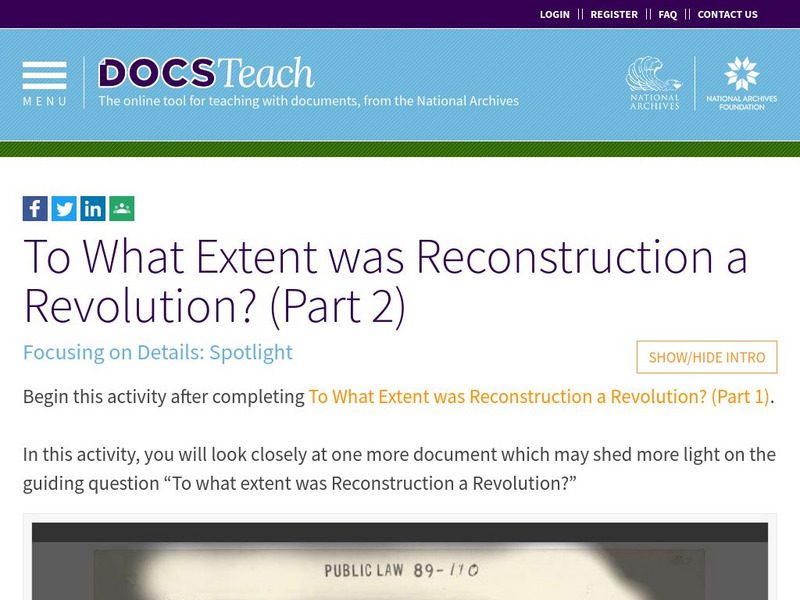
![Digital History: Affirmative Action and the Case of Allan Bakke [Pdf] Website Digital History: Affirmative Action and the Case of Allan Bakke [Pdf] Website](https://d15y2dacu3jp90.cloudfront.net/images/attachment_defaults/resource/large/FPO-knovation.png)

